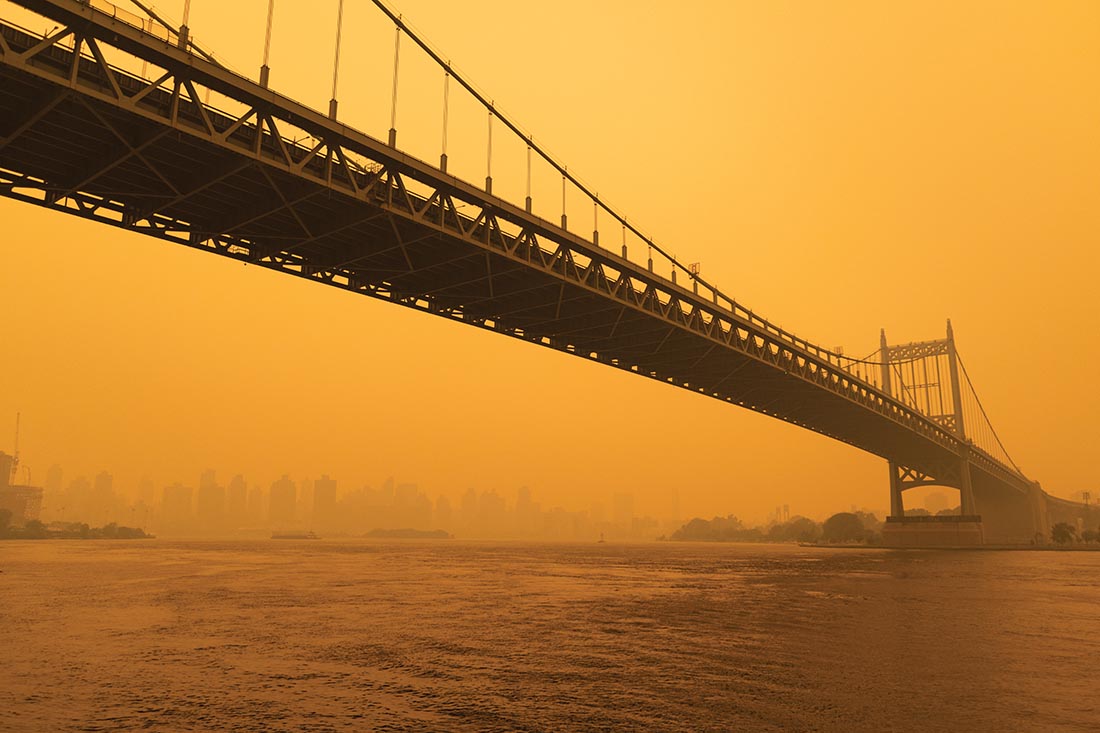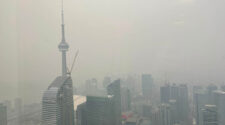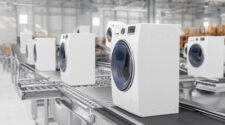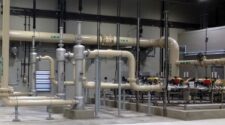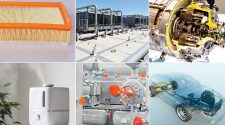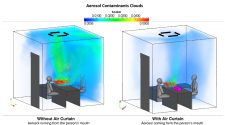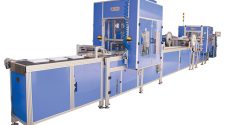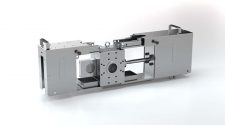There are occasions when the knowledge and experience a person has developed over their professional career intersects with their personal life. Such is the case for many in the air filtration industry who are unfortunate enough to find themselves in areas where air quality is jeopardized by wildfire smoke. While generally considered to be an issue that those living in the Western half of the United States deal with every year, vast portions of the Northeast and Upper Midwest experienced weeks of air quality alerts in the summer of 2023 due to wildfires in Central and Eastern Canada.
In 1999, the Environmental Protection Agency (EPA) created a measure for the quality of the air known as the Air Quality Index (AQI), which is easily accessed through the website AirNow.gov. A network of sensors around the nation reports the current air quality for five pollutants; ground-level ozone, fine particle pollution, carbon monoxide, sulfur dioxide, and nitrogen dioxide. Alerts are announced when the AQI Index for a given area is deemed to be unhealthy. There is a specific area of AirNow dedicated to conditions created by wildfire smoke.
Air filtration professionals, accustomed to troubleshooting and recommending solutions for a wide range of industrial and commercial applications, now use these skills in their homes and those of their family and friends when the AQI Index climbs due to wildfire smoke. The same steps used when troubleshooting on a job are followed and one of the first steps to improving air quality is to identify the particles of concern and determine how best to remove those from the indoor environment.
Two Hazardous Components of Wildfire Smoke
Wildfire smoke is comprised of particulate matter and various gaseous substances.
Particulate matter generated by burning matter become suspended in the air and carried vast distances. While the smoke odor is a nuisance, the fine particles are harmful to human health.
Gaseous substances are released by the process of combustion. These include nitrogen dioxide, various volatile organic chemicals (VOC), and ozone. Due to the presence of other powerful odors, ozone is sometimes not immediately detected by our sense of smell. The damage ozone can do is sometimes described as a sunburn on your lungs.
The exact mixture of wildfire smoke for both particulate matter and gases depends on what’s burning, what stage the fire is in, and how hot the fire is. An intense fire with visible flames can produce one mixture while a smoldering fire produces another. And as the distance increases from the source of the fire, the dynamics of the smoke can change as larger particles settle and gases disperse. As such, knowing exactly what type and size of particulate matter and gaseous substances are in the smoke is often difficult to predict.
Particulate Filtration
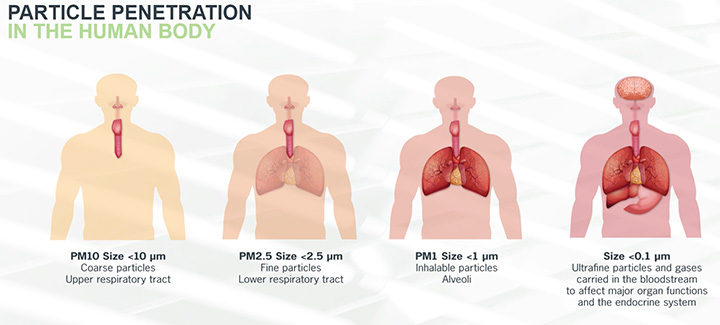
From an air filtration point of view, controlling particulate matter from a wildfire requires a different approach than controlling the gaseous substances released during that same fire.
Particulate matter is broken down into one of three categories based on size: PM10, PM2.5, and PM1. The size of a particle dictates how far into the human body it could penetrate. PM10 particles are coarse particles 10 microns and smaller, PM2.5 particles are 2.5 microns and smaller and PM1 are 1 micron and smaller. Particles with a diameter of less than one micron are sometimes referred to as ultrafine particles. The AQI Index for particle pollution is calculated based on the level of only PM2.5 and PM10 particles, not PM1 or ultrafine particles.
For particulate filtration, general ventilation air filters are tested and classified by their particle capture efficiency and assigned a performance value according to test procedures outlined in ASHRAE Standard 52.2 or ISO Standard 16890. Standard 52.2 test filters against particle sizes ranging from 0.3 to 10 microns while ISO16890 classifies performance based on PM10, PM2.5, and PM1 particle capture. While wildfire smoke varies according to the fire and what’s being burned, 90% of the particulate mass in wildfire smoke is comprised of PM2.5 particles.
When testing an air filter to assign a MERV value according to 52.2 or ePM percentage according to 16890, calibrated test dust whose particle composition is well-defined, is fed into a test duct with a new filter installed. Based on how well a filter captures particles in each various size ranges, 52.2 assigns a MERV value between 1 and 16 while ISO assigns a ePM average. It’s important to note that the ISO16890 test includes a procedure to account for efficiency drop-off due to electrostatic degradation while a similar procedure in 52.2 is an optional appendix. Note: after 1/1/25, the new ASHRAE Standard 241 requires filters tested under 52.2 to include the optional test, known as Appendix J, and designate the results as the filter’s MERV-A value.
Earlier it was stated that 90% of wildfire smoke is estimated to be comprised of PM2.5 particles and high-quality, non-degrading general ventilation air filters can achieve 90-95% particle capture efficiency on particles of this size. However, in a large fire or multiple fires where smoke merges and travels hundreds of miles, the number of ultrafine particles that penetrate high-efficiency filters is significant and represents a serious health hazard, particularly when the smoke event lasts for days. This is where HEPA filtration plays a role.
The common definition of a HEPA in the U.S. following IEST-RP-CC001, is one tested to a minimum efficiency of 99.97% on 0.3-micron particles. HEPA filters with higher efficiencies can be produced as well. Other HEPA test standards, EN1822 or ISO29463, classify efficiency performance on most penetrating particle size (MPPS) which is generally between 0.1 and 0.2 microns. The minimum efficiency considered to be a HEPA filter according to those standards is 99.95% on MPPS.
While air handling units serving industrial and commercial spaces are typically capable of holding high MERV-rated air filters, HEPA filters require special frames and stronger fans to overcome their higher resistance. For a residence, it’s unlikely MERV 14 or MERV 16 air filters (or ISO16890 equivalent) are an option unless the unit has been reconfigured to hold a larger, six- or 12-inch-deep filter which would lower the resistance to suitable levels. The resistance (aka pressure drop) on a thinner, 2- or 4-inch panel-type filter rated a MERV 14 or 16 would likely be far too high for a residential unit, especially if the filter is a legitimate MERV 14A or 16A. In those cases, a stand-alone air purifier with HEPA filtration to supplement the HVAC system could be considered. It operates independently of the HVAC system. The majority of air purifiers are portable and can be moved to areas impacted by wildfire smoke that caused clean air alerts.
Gas-Phase Filtration
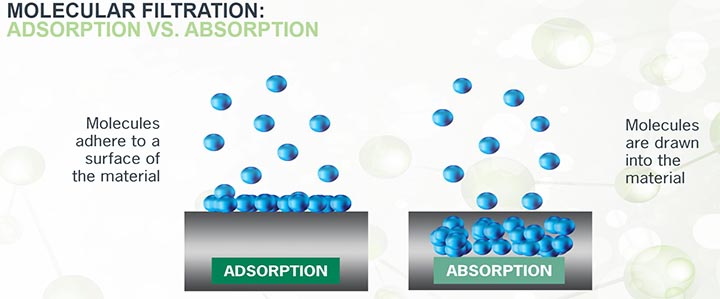
Controlling the gaseous pollutants produced in a wildfire can be more challenging. Jennifer Webb is the Molecular Segment Manager for Camfil USA covering the Western portion of the U.S. which includes Northern California where she lives. Having lived near prime wildfire country most of her life, smoke-filled skies are almost a seasonal occurrence with some years being worse than others. As her career in the air filtration industry took shape, she was able to use the knowledge gained in molecular filtration to better protect her family and friends during particularly bad air quality alert days.
Jennifer explains molecular filtration. “Molecular filtration involves a technique known as adsorption to capture particles at their molecular level, thousands of times smaller than what the best HEPA filters can capture. Adsorption, with a “d,” is different from the more common word, absorption, with a “b.” In absorption, the molecules are drawn into the material and cannot easily be separated again such as milk added to coffee. In adsorption, molecules adhere only to the surface of the material and remain separate, such as a sponge adsorbing water.”
“Unlike air filters that use a fibrous media, molecular filtration relies on a porous media like activated carbon, commonly made from carbonized coconut shells. If you were to view a piece of activated carbon under strong magnification, you would see the surface fractured with deep canyons and cave-like structures. This greatly increases the surface area of the material to such an extent that if a spoonful of activated carbon were spread flat, it would cover an entire football field.”
“When the various gases created in a wildfire encounter an activated carbon filter, the molecules making up the gas are physically attracted to the surface of the media by weak intermolecular forces. This attraction holds the molecule in place and removes it from the airstream.”
Molecular air filters can look similar to general ventilation filters, but with activated carbon included in the design, or they can look dramatically different and require specialized housings to hold the cylinders or modules.
Strategies To Keep Smoke Out
In the U.S., there’s an average of almost 70,000 individual wildfires per year(1) and the number of acres burned recently has been as high as ten million. Strategies to prevent wildfire smoke from entering a facility depend on the design of the building and its HVAC equipment. Commercial, retail, or industrial buildings for example generally have more complex HVAC systems than smaller stand-alone buildings and residences. Commercial spaces often have minimum requirements for how much outside air must be brought into the building based on size, intended use, or occupancy. But the buildings may also have requirements to exhaust air from certain spaces such as kitchens or restrooms.
When wildfire smoke surrounds a building, positive air pressure inside creates a barrier that helps keep smoke from entering through open doors, windows, and unseen cracks. If the air pressure inside a building, or a separate space within the building, is lower than the surrounding area, a pressure differential exists and air will naturally flow from higher to lower. Exhausting air can create a low-pressure zone and a pathway for smoke to enter. For commercial, retail, and industrial facilities, this can be difficult to manage since employees, customers, shipping, and deliveries can continue during business hours. This is a little easier to manage in smaller facilities or residences, but there are surprising day-to-day activities such as running a dryer or range hoods that need to be monitored. Exhausting that air could be enough to tip the scales from positive to negative.
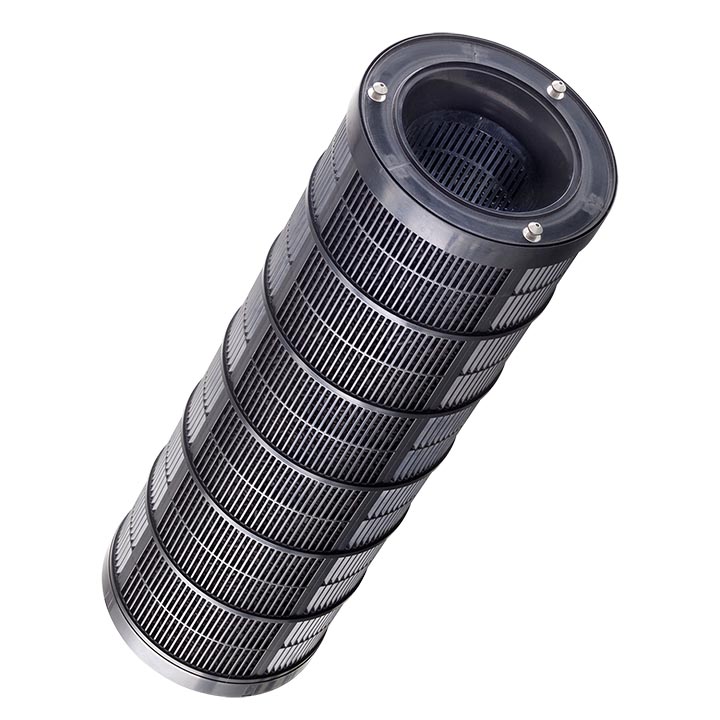
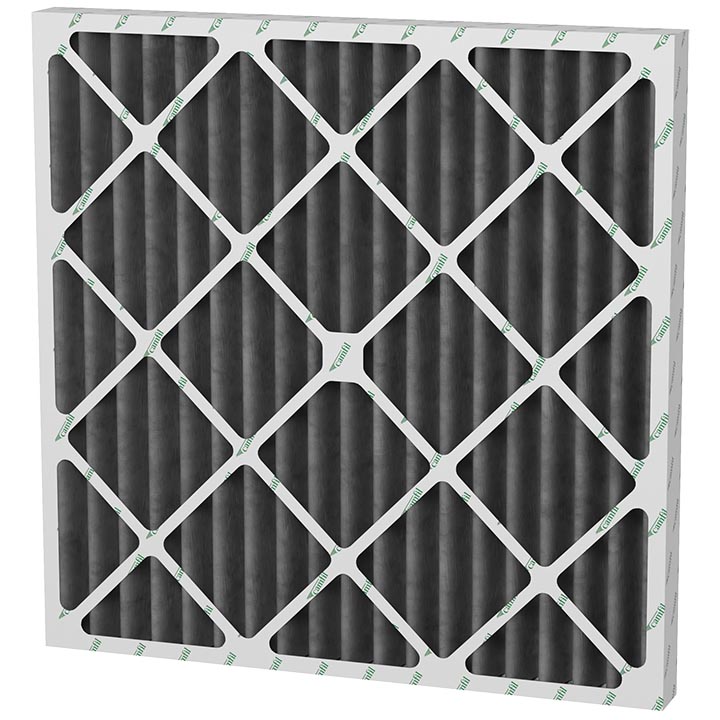
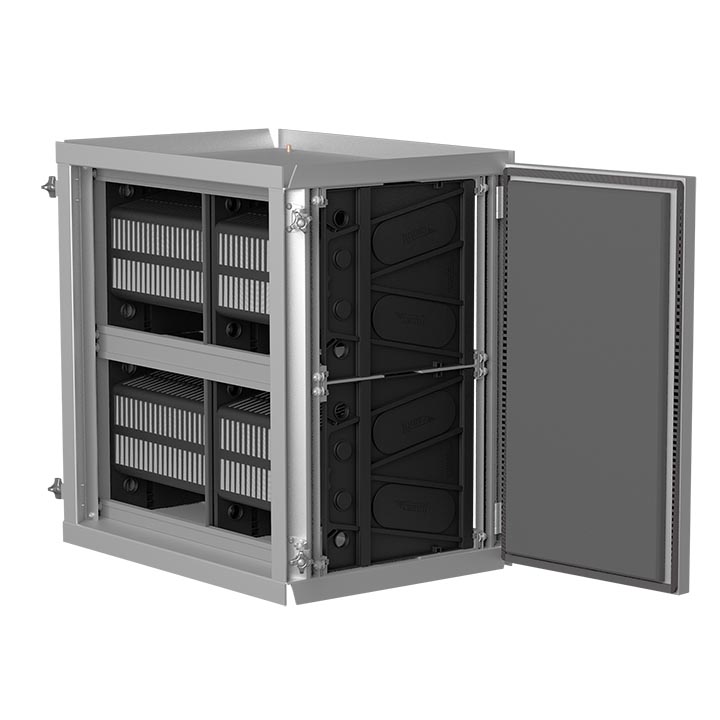
Ultimately, outside air polluted with wildfire smoke will get into a facility. It could be unintentional when pressure slips or it could be because the HVAC equipment must run to bring in warmed or cooled air. When this happens, air filters in the HVAC system or in stand-alone air purifiers can be used to remove the PM and gaseous pollutants within the smoke.
Most commercial HVAC equipment has the capability to adjust the amount of outside air brought inside. Setting the system to recirculate as much air as possible gives the air filters multiple opportunities to filter the same unit of air. As mentioned before, high-efficiency air filters capture a high percentage of PM2.5 in a single pass, and multiple passes through an air filter with a lesser efficiency can also be effective. However, there’s still the issue of ultrafine particles below the capability of high-efficiency air filters especially during times of extreme wildfire events. Stand-alone individual room air purifiers with HEPA filters are useful in this situation. There may be certain areas of a facility where managing smoke is more difficult than others, such as in shipping and receiving. In those situations, areas of the facility with greater occupancy such as office or shopping spaces, can be isolated with both physical barriers and barriers created by air pressure. Within these areas, air can continually be recirculated through the air purifiers. This is true for homes as well. Many air purifiers also contain molecular filters that target the gaseous pollution from wildfire smoke.
Jennifer Webb was in this situation and was able to use her experience in both particulate and gaseous filtration. “Since the highest my house’s HVAC system could accept is a MERV11 filter and while I could set the fan to recirculate the air continuously, I wanted to find a separate recirculating system that would capture the smaller particles more efficiently. I also wanted it to capture any ozone gas that might be present. And finally, back to the very beginning of our conversation, I wanted something to remove the nuisance odors. So not only did I need something with a higher MERV value, but I also needed a molecular- or carbon-filter to capture the odors and gases.”
Wildfire smoke contains both particulate matter and gaseous pollutants. Each requires a specific type of air filter to manage the contaminant levels. While there are strategies to limit smoke from entering buildings, it’s likely smoke will find a way inside. Relying on what air filtration professionals have learned is a good starting point to protect human health.

After completing her BS in Mechanical Engineering from the University of Delaware, Jennifer Webb worked in various product, process and sales engineering roles in the aerospace and semiconductor manufacturing industries.
Jennifer Webb joined Camfil in 2019 as the Molecular Filtration Segment Manager for the western United States and Mexico. She is responsible for technical sales, marketing and business development of molecular (aka-”carbon“ or “gas-phase”) filtration solutions for a wide range of industries and applications, including airports, hospitals, cannabis, cultural heritage preservation, petrochemical, wastewater, pulp and paper, industrial exhaust and biogas.


